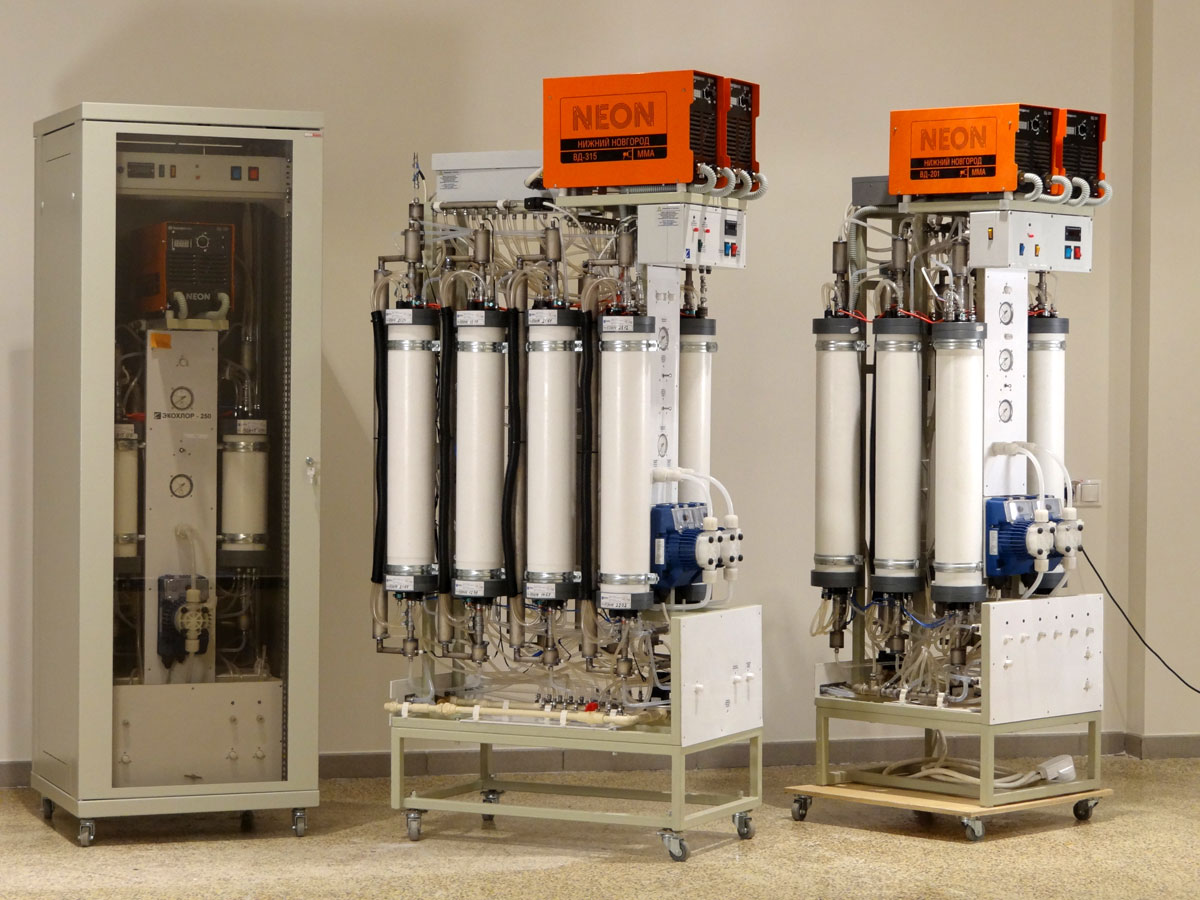ECOCHLOR
ECOCHLOR (AQUATRON-25) is a class of devices for electrochemical synthesis of gaseous chlorine and concentrated solution of caustic soda. The AQUATRON-25 device are compact safe modular chlor-caustic plants that have no analogues in the world. The capacity of a single module varies from 1 to 10 kg / h in gaseous chlorine.
Technological schemes of electrochemical synthesis processes in the AQUATRON-20 and AQUATRON-25 devices are distinguished by systems at the outlet of chlorine from the anode circuit, where the pressure can be in the range from 1 to 6 atm. In the AQUATRON-25 devices, unlike the AQUATRON-20 devices, arrangements are required for heating the chlorine before the pressure stabilizer and the moisture extraction system before feeding to consumers. The AQUATRON-25 devices are manufactured in accordance with the patents of the Russian Federation No. 2270885, 2350692.

ECOCHLOR-003 device, model of 2012.
The class of electrochemical systems AQUATRON-25 until 2016 was represented by a model range of ECOCHLOR devices with a maximum chlorine capacity of 500 g / h. The use of electrochemical elements with high volumetric current density in ECOCHLOR devices allowed to increase the productivity of these plants by three times with chlorine and caustic soda, while maintaining the previous energy consumption (by reducing the voltage on electrochemical modular elements) and with constant overall dimensions of the device, and also allowed to create modular ECOCHLOR devices with a single chlorine capacity of up to 10 kg/h.
ECOCHLOR device is a compact, environmentally friendly, economical, high-performance module for the production of chlorine and caustic soda solution at the site of their consumption. The ECOCHLOR-003 device is a modular device with dimensions 60 × 60 × 180 cm with a capacity of 3 kg / h of gaseous chlorine and electric power consumed of 9.0-9.6 kWh. The ECOCHLOR-003 device uses the latest Bakhir modules MB-1600 with a capacity of 1600 g / h each. Such devices allow the creation of safe, energy efficient and environmentally friendly plants for the production of chlorine and caustic soda.
Perspectives
Total replacement of chlorine plants to ecologically clean manufactures at places of use of chlorine and hydrate of sodium, that allows to exclude system and appropriate equipment for chlorine dehydration, transportation and storage as well as special safety systems under chlorine usage.
Advantages:
- conversion level of initial solution of sodium chloride is 99,5%;
- it is not required complex technology of initial brine solution treatment,
- it is not required license of GOSGORTECHNADZOR organization;
- chlorine yield from 1 square meter of area occupied by ALL the equipment of module work is 6,0 kilograms per hour of chlorine or 144 kilograms per day of chlorine;
- specific energy consumption for synthesis of 1 kg of chlorine is 3,0 – 3,2 kWh;
- it is not required making new special buildings. All the equipment is placed in dry airing manufacturing facilities with electric power lines, water supply, initial brine solution supply lines and sewerage system;
- every module at factory (ECOCHLOR device) is completely autonomous and can be replaced in case of need in at any moment without stopping of the whole manufacture.
| Parameters | Value |
| Chlorine production rate, kg/h | 10.0 |
| Sodium hydroxide production rate, kg/h | 11.4 |
| Potassium hydroxide production rate, kg/h | 16.0 |
| Chlorine current output, % | 98 - 99 |
| DC power consumption for chlorine production, kW×h/t | ~2800 |
| DC power consumption for sodium hydrate production, kW×h/t | ~2456 |
| DC power consumption for potassium hydrate production, kW×h/t | ~1750 |
| Sodium hydroxide concentration in catholyte, g/l | ~180 |
| Potassium hydrate concentration in catholyte, g/l | ~200 |

